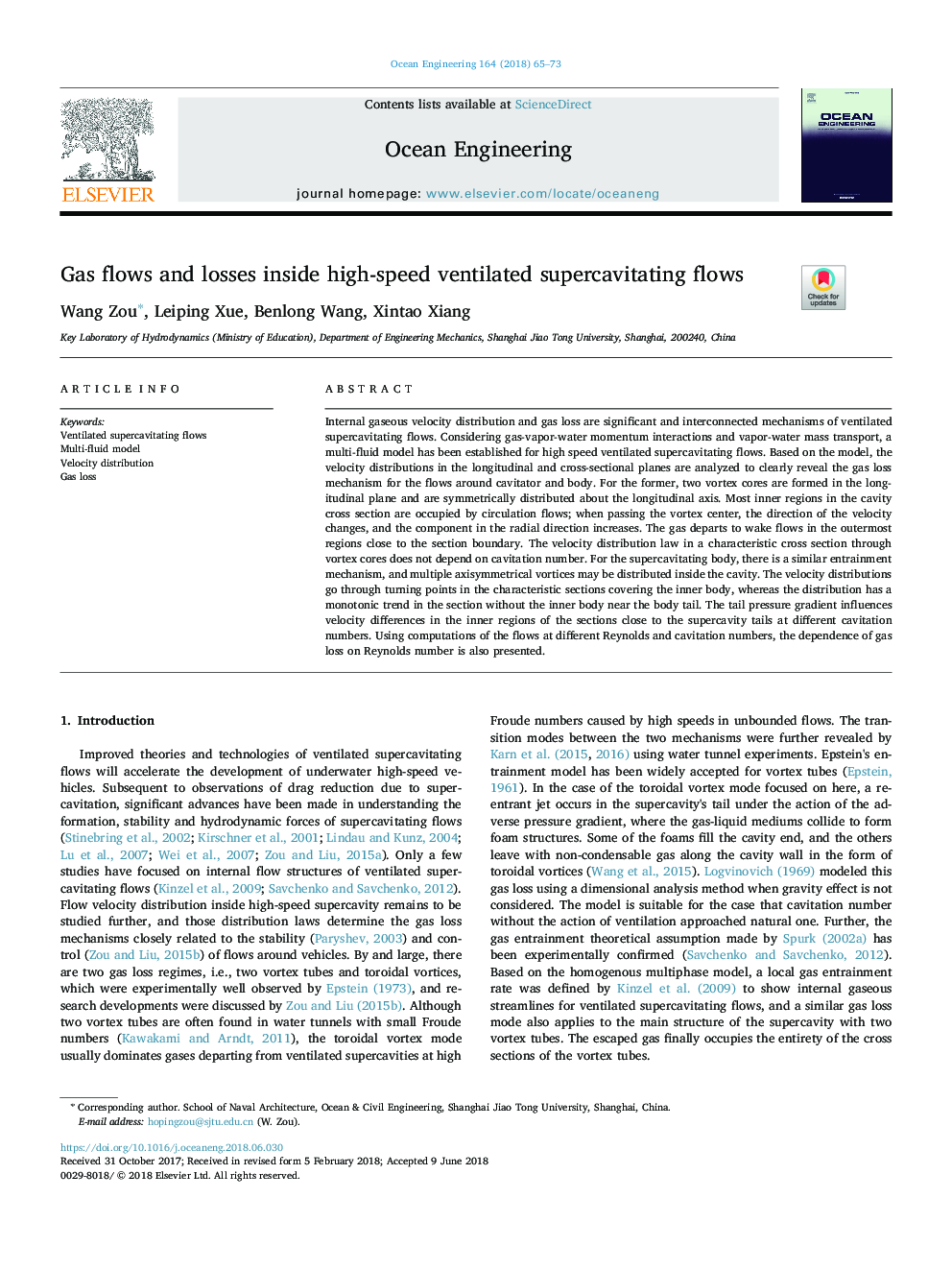| کد مقاله | کد نشریه | سال انتشار | مقاله انگلیسی | نسخه تمام متن |
|---|---|---|---|---|
| 8061852 | 1520626 | 2018 | 9 صفحه PDF | دانلود رایگان |
عنوان انگلیسی مقاله ISI
Gas flows and losses inside high-speed ventilated supercavitating flows
ترجمه فارسی عنوان
جریان و جریان گاز درون جریان فوق العاده ای تهویه شده با سرعت بالا
دانلود مقاله + سفارش ترجمه
دانلود مقاله ISI انگلیسی
رایگان برای ایرانیان
کلمات کلیدی
جریانهای سوپرکاویتیو هدایت شده، مدل مایع مایع توزیع سرعت، از دست دادن گاز،
ترجمه چکیده
توزیع سرعت گاز داخلی و از دست دادن گاز، مکانیزم های قابل ملاحظه ای از جریان های ابرقرنطقی تهویه ای هستند. با توجه به تعاملات مولد گاز-بخار-آب و انتقال جرمی بخار-آب، مدل چندسیلی برای جریانهای سوپرکابایتی تهویه با سرعت بالا ایجاد شده است. بر اساس مدل، توزیع سرعت در هواپیما های طولی و عرضی تجزیه و تحلیل شده است تا به طور واضح مکانیزم از دست دادن گاز را برای جریانهای اطراف کاویتاتور و بدن نشان دهد. برای اولین بار، دو هسته پیچ خورده در هواپیما طولی تشکیل شده و تقریبا در محور طولی توزیع می شوند. بیشتر قسمت های داخلی در قسمت حفره حفره ها توسط جریان های گردش خون جذب می شوند. هنگام عبور از مرکز گرداب، جهت سرعت تغییر می کند و مولفه در جهت شعاعی افزایش می یابد. گاز از جریان خارج می شود در مناطق دور افتاده نزدیک به مرز بخش. قانون توزیع سرعت در یک مقطع مشخصه از طریق هسته های گرداب به تعداد کاویتاسیون وابسته نیست. برای بدن فوقانی، یک مکانیزم تخریب مشابه وجود دارد و می تواند درون حفره توزیع شود. توزیعهای سرعت از طریق نقاط تبدیل در بخش های مشخص شده پوشش بدن درونی، در حالی که توزیع یک روند مونوتونی در بخش بدون بدن داخلی در نزدیکی دم بدن دارد. شیب دم دم بر تفاوت های سرعت در قسمت های داخلی بخش هایی که در نزدیکی دم دمبرگ در اعداد مختلف کاویتاسیون تاثیر می گذارد، تأثیر می گذارد. با استفاده از محاسبات جریان در رینولدز و تعداد حفره های مختلف، وابستگی از دست دادن گاز به تعداد رینولدز نیز ارائه شده است.
موضوعات مرتبط
مهندسی و علوم پایه
سایر رشته های مهندسی
مهندسی دریا (اقیانوس)
چکیده انگلیسی
Internal gaseous velocity distribution and gas loss are significant and interconnected mechanisms of ventilated supercavitating flows. Considering gas-vapor-water momentum interactions and vapor-water mass transport, a multi-fluid model has been established for high speed ventilated supercavitating flows. Based on the model, the velocity distributions in the longitudinal and cross-sectional planes are analyzed to clearly reveal the gas loss mechanism for the flows around cavitator and body. For the former, two vortex cores are formed in the longitudinal plane and are symmetrically distributed about the longitudinal axis. Most inner regions in the cavity cross section are occupied by circulation flows; when passing the vortex center, the direction of the velocity changes, and the component in the radial direction increases. The gas departs to wake flows in the outermost regions close to the section boundary. The velocity distribution law in a characteristic cross section through vortex cores does not depend on cavitation number. For the supercavitating body, there is a similar entrainment mechanism, and multiple axisymmetrical vortices may be distributed inside the cavity. The velocity distributions go through turning points in the characteristic sections covering the inner body, whereas the distribution has a monotonic trend in the section without the inner body near the body tail. The tail pressure gradient influences velocity differences in the inner regions of the sections close to the supercavity tails at different cavitation numbers. Using computations of the flows at different Reynolds and cavitation numbers, the dependence of gas loss on Reynolds number is also presented.
ناشر
Database: Elsevier - ScienceDirect (ساینس دایرکت)
Journal: Ocean Engineering - Volume 164, 15 September 2018, Pages 65-73
Journal: Ocean Engineering - Volume 164, 15 September 2018, Pages 65-73
نویسندگان
Wang Zou, Leiping Xue, Benlong Wang, Xintao Xiang,
